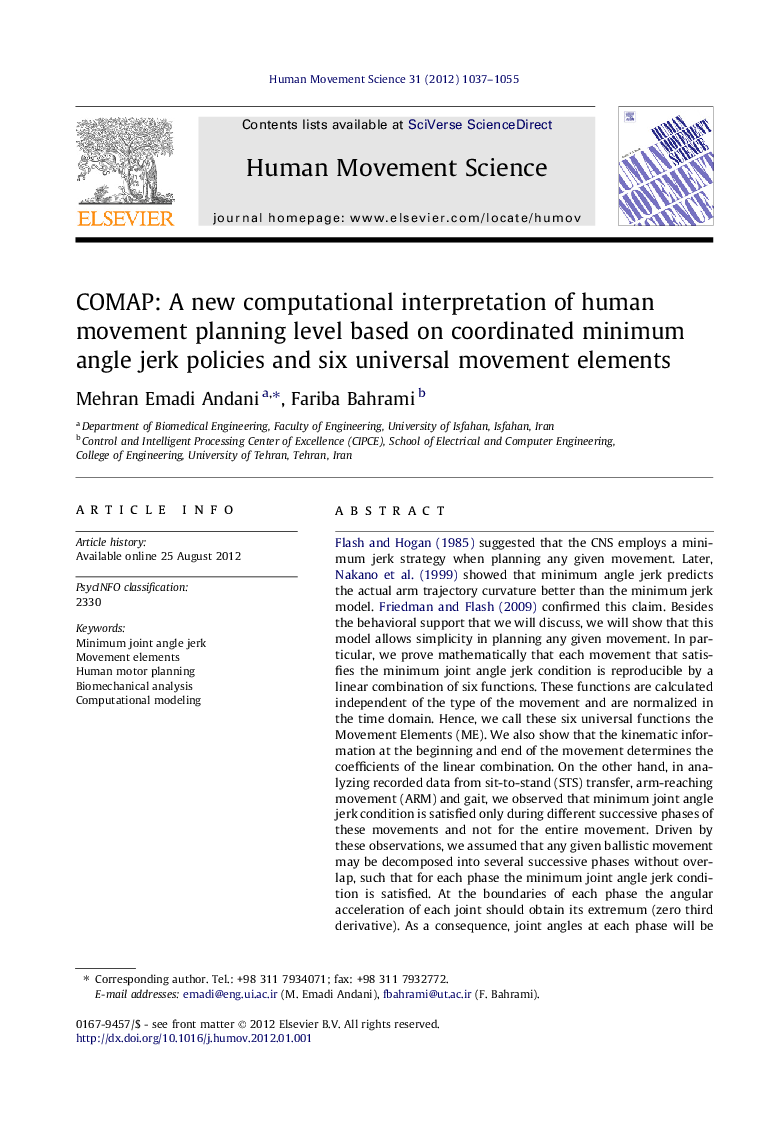| کد مقاله | کد نشریه | سال انتشار | مقاله انگلیسی | نسخه تمام متن |
|---|---|---|---|---|
| 928369 | 922362 | 2012 | 19 صفحه PDF | دانلود رایگان |

Flash and Hogan (1985) suggested that the CNS employs a minimum jerk strategy when planning any given movement. Later, Nakano et al. (1999) showed that minimum angle jerk predicts the actual arm trajectory curvature better than the minimum jerk model. Friedman and Flash (2009) confirmed this claim. Besides the behavioral support that we will discuss, we will show that this model allows simplicity in planning any given movement. In particular, we prove mathematically that each movement that satisfies the minimum joint angle jerk condition is reproducible by a linear combination of six functions. These functions are calculated independent of the type of the movement and are normalized in the time domain. Hence, we call these six universal functions the Movement Elements (ME). We also show that the kinematic information at the beginning and end of the movement determines the coefficients of the linear combination. On the other hand, in analyzing recorded data from sit-to-stand (STS) transfer, arm-reaching movement (ARM) and gait, we observed that minimum joint angle jerk condition is satisfied only during different successive phases of these movements and not for the entire movement. Driven by these observations, we assumed that any given ballistic movement may be decomposed into several successive phases without overlap, such that for each phase the minimum joint angle jerk condition is satisfied. At the boundaries of each phase the angular acceleration of each joint should obtain its extremum (zero third derivative). As a consequence, joint angles at each phase will be linear combinations of the introduced MEs. Coefficients of the linear combination at each phase are the values of the joint kinematics at the boundaries of that phase. Finally, we conclude that these observations may constitute the basis of a computational interpretation, put differently, of the strategy used by the Central Nervous System (CNS) for motor planning. We call this possible interpretation “Coordinated Minimum Angle jerk Policy” or COMAP. Based on this policy, the function of the CNS in generating the desired pattern of any given task (like STS, ARM or gait) can be described computationally using three factors: (1) the kinematics of the motor system at given body states, i.e., at certain movement events/instances, (2) the time length of each phase, and (3) the proposed MEs. From a computational point of view, this model significantly simplifies the processes of movement planning as well as feature abstraction for saving characterizing information of any given movement in memory.
Journal: Human Movement Science - Volume 31, Issue 5, October 2012, Pages 1037–1055